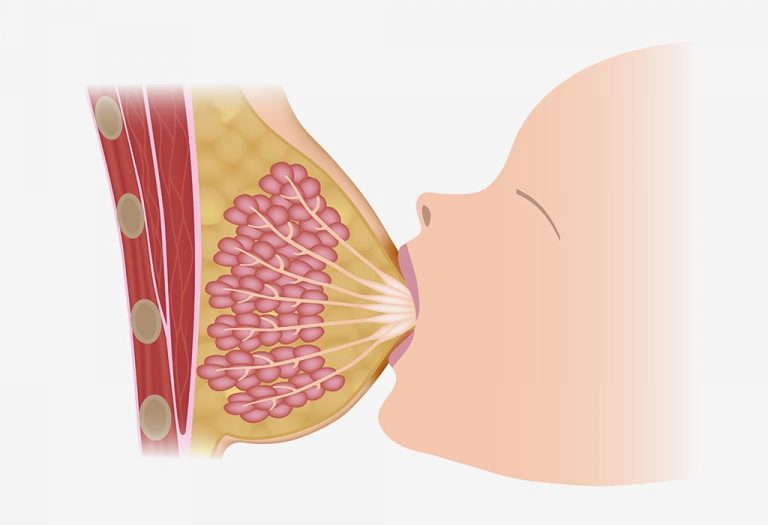Let-Down Reflex (Milk Ejection Reflex) – What Is It, Causes and Signs

The process of breastfeeding is rather complex, involving a combination of physical, emotional, and hormonal factors that work together to ensure successful milk production and delivery. Everything from the proximity to your baby to hormonal changes, such as the release of oxytocin, plays a crucial role in facilitating breast milk production and release. One key aspect of this process is the milk let-down reflex, which is triggered by the baby’s suckling and signals the breasts to release milk. In this article, we will explore closely the working of the let-down reflex and the various factors that influence it, such as stress, relaxation, and the mother’s overall health.
What Is the Let-Down Reflex?
Here’s the letdown breastfeeding meaning. Let-down reflex is the process by which a mother’s body releases milk for a hungry baby (1). When a baby sucks at her mother’s breast, sensitive nerves of the nipple are triggered to release hormones into the bloodstream. Two such hormones, prolactin and oxytocin, are directly responsible to assist with breastfeeding. Prolactin triggers the production of milk in the breast, while oxytocin causes the breast to let-down or allow the milk to flow. Oxytocin not only pushes the milk out by contracting the cells around the alveoli, but also widens the milk ducts to allow the milk to flow more easily. This process makes the breast milk available for the baby to feed.
Let-down reflex while breastfeeding allows the baby to feed as she sucks on the mother’s nipples and plays a vital role in the nourishment of the child.
How Does the Let-Down Reflex Feel?
During the let-down reflex, you may feel a few sensations going through in your body. Here are some things that you may feel at this time (2).
- A tingling feeling in the breasts.
- Cramps in the uterus mostly in the first few days post-delivery.
- A feeling of fullness in the breasts.
- Milk dripping from the breast.
- The baby’s feeding action changing from sucking to swallowing.
When Does the Breastfeeding Let Down Reflex Occur?
The breastfeeding let-down reflex involves the release of milk from the breast in response to the baby’s suckling or other stimuli. Understanding when and how this lactation letdown reflex occurs can help mothers better manage their breastfeeding journey and address any challenges they may face.
- During Feeding: The let-down reflex typically occurs a few seconds to a couple of minutes after the baby begins suckling, as the brain releases oxytocin to stimulate milk flow.
- Before Feeding: Some mothers may experience the let-down reflex even before feeding begins, often triggered by hearing their baby cry or thinking about their baby.
- Multiple Let-Downs: During a single feeding session, a mother may experience the let-down reflex multiple times, especially if the feeding is prolonged.
- Emotional Triggers: Feelings of relaxation, bonding, or even stress can influence the timing and effectiveness of the let-down reflex.
- Pumping Sessions: The reflex can also occur during pumping, as the suction mimics the baby’s suckling, signalling the brain to release oxytocin and initiate milk flow.
Ways to Improve Let Down Reflex
The let-down reflex is a crucial part of breastfeeding, ensuring that milk flows effectively for your baby. However, some mothers may experience difficulties with this reflex, which can be improved through the following simple techniques and mindful practices (3).
- Relaxation Techniques: Practice deep breathing, meditation, or gentle massage to reduce stress and create a calm environment, as relaxation helps trigger oxytocin release.
- Skin-to-Skin Contact: Holding your baby close or engaging in skin-to-skin contact can stimulate the let-down reflex by enhancing bonding and hormonal responses.
- Warm Compresses: Applying a warm compress to your breasts before feeding can help relax the milk ducts and encourage milk flow.
- Consistent Feeding or Pumping: Regular breastfeeding or pumping sessions can train your body to respond more efficiently to the baby’s suckling or the pump’s suction.
- Visualisation: Visualising your baby or thinking about their cues, such as their cry or smile, can mentally prepare your body for milk let-down.
What Is an Overactive Let-Down?
An overactive or forceful let-down is when the milk from a mother’s breast is flowing too quickly and in large quantities. An overactive let-down usually is the result of an oversupply of milk or the fact that the mother’s body has not adjusted to the babies feeding needs and pattern (4).
Causes of a Forceful Let-Down
A forceful let-down may occur due to the following reasons.
- An oversupply of milk.
- A sudden increase in the baby’s feeding requirements.
- Excessive milk production on account of a temporary increase in the baby’s feeding pattern. If a baby starts feeding too often, the breast will get full quicker.
Symptoms of Overactive Let-Down and Reflex
Most symptoms of an overactive let-down can be identified by observing the feeding baby. If a baby is pulling away from the breasts or is gagging and coughing this could indicate an overactive letdown. If a baby is making clicking sounds while feeding or is refusing to be breastfed this could also indicate an overactive letdown (5).
Complications of Milk Ejection Reflex
The milk ejection reflex, or let-down reflex, is a vital part of breastfeeding, but it can sometimes come with complications that may affect both the mother and the baby. Understanding these challenges can help in identifying and addressing them effectively.
1. Overactive Let-Down
An overactive let-down can cause milk to flow too quickly, making it difficult for the baby to latch properly or causing them to choke or gag. This can lead to frustration for both the mother and the baby during feeding sessions.
2. Delayed or Weak Let-Down
Some mothers may experience a delayed or weak let-down reflex, where milk flow is slow or insufficient. This can result in the baby not getting enough milk, leading to poor weight gain or feeding difficulties. Stress, fatigue, or medical conditions can often contribute to this issue.
3. Pain or Discomfort
In some cases, the let-down reflex can cause pain or discomfort, such as a tingling or burning sensation in the breasts. This may be due to engorgement, blocked ducts, or conditions like mastitis, which can make breastfeeding uncomfortable or challenging.
Is an Overactive Let-Down Painful?
An overactive let-down can have different effects on women; some women complain of an intense pins-and-needle feeling, some complain of intense pain, while some mothers barely notice it. By and large, an overactive let-down can fill the breasts with excessive milk and they can feel swollen causing pain.
How to Deal with an Overactive Let-Down
Here are a few ways you could control or deal with an overactive let-down (6).
- Increase the frequency of breastfeeding, you should be breastfeeding the baby every two and a half to three hours.
- Allow sufficient time for the baby to feed on each breast.
- Offer only one breast to the baby per feeding.
- Try nursing the baby in a laid back or reclined position to make it easier.
- Squeeze the areola in a C or V position, this will allow the baby to feed at a controlled rate.
- Expressing some milk before breastfeeding should slow the rate of flow while breastfeeding.
- Massaging the breasts before feeding can also prove useful.
These were some of the ways to deal with an overactive milk ejection reflex.
What Is a Slow Let-Down?
The opposite of an overactive let-down is a slow let-down. A slow let-down can cause difficulties with the flow of milk; the milk will flow slowly and may even be painful. A slow let-down can also affect a baby adversely; it is difficult for a hungry baby to cope with slow let-down when he wants to feed. A baby may get frustrated and cry more often on account of hunger, or bite on the breast to try and get more milk.
Causes of a Slow Let-Down
The primary causes of slow let-down identified so far are (7):
- Stress
- Exhaustion
- Physical discomfort of any sort
- Consumption of alcohol
- Smoking cigarettes
Let-Down Reflex Pain
Let-down reflex can cause pain and discomfort particularly in the first two weeks after childbirth. Shooting pain in the breasts and painful contractions of the uterine muscles may be experienced. Let-down reflex may also result in cracked nipples and cause the breasts to become hard and swollen. Such painful experiences may interfere with breastfeeding and necessary bonding sessions between the mother and child. In case of severe complications, expert help and medical advice should be sought.
Dealing With a Slow Let-Down
Here are some ways you can deal with a slow let-down:
- Anxiety and stress can further complicate slow let-down, it is crucial that the mother maintains a relaxed composure before and during breastfeeding.
- Breast compressions can be useful in assisting the flow of milk.
- Touching the baby lovingly or expressing affection can aid in the release of oxytocin, which will assist with the flow of milk.
- Pumping before breastfeeding should also prove helpful.
- The intake of certain herbs like fennel can also be helpful with milk let-down reflex.
FAQs
1. Can the let-down reflex occur in non-breastfeeding individuals?
Yes, the let-down reflex can occasionally occur in non-breastfeeding individuals, particularly those who have previously breastfed. This can happen due to hormonal changes, stimulation of the nipples, or even emotional triggers like hearing a baby cry. However, it is rare and usually not accompanied by milk production.
2. Can the let-down reflex cause leaking in public?
Yes, some breastfeeding mothers may experience unexpected leaking or let-down in public due to triggers like hearing a baby cry, thinking about their baby, or even feeling emotional. This can be managed with nursing pads or by applying gentle pressure to the nipples to stop the flow.
3. Can the let-down reflex be triggered by someone else’s baby?
In some cases, a mother’s let-down reflex can be triggered by another baby’s cry or presence, especially if she is actively breastfeeding. This is due to the brain’s hormonal response to cues associated with breastfeeding, even if the baby is not her own.
This was all about the ejection of milk or the letdown reflex. Let-down reflex is crucial for breastfeeding, but as explained above, there may be complications in some instances. The two most common complications are an overactive let-down and a slow let-down. For the most part, both these complications can be remedied, and it is important for the mother to maintain her composure and relax. In case of severe complications, medical assistance and expert consultation should fix the problem. Breastfeeding is essential for the bonding between a mother and her baby, it is a natural process and difficulties faced in the beginning may get sorted on their own.
References/Resources:
1. Pregnancy, Birth & Baby – Let-down reflex
2. Province of Manitoba – Baby Friendly Manitoba: Information for Parents
3. Cleveland Clinic – What To Know About the Breastfeeding Let-Down
4. Johns Hopkins Medicine – Overactive Let-Down
5. La Leche League Canada – Oversupply and Forceful Letdown (Milk Ejection Reflex)
6. Breastfeeding Support for Indian Mothers – Fast Letdown/ Overactive Letdown/ Forceful Letdown
7. Australian Breastfeeding Association – The let-down reflex and your milk flow
Also Read:
Common Neonatal Reflexes
Stress and Breastfeeding
Understanding Sucking Reflex in Babies
Breastfeeding Latching Problems and Solutions
Was This Article Helpful?
Parenting is a huge responsibility, for you as a caregiver, but also for us as a parenting content platform. We understand that and take our responsibility of creating credible content seriously. FirstCry Parenting articles are written and published only after extensive research using factually sound references to deliver quality content that is accurate, validated by experts, and completely reliable. To understand how we go about creating content that is credible, read our editorial policy here.

























